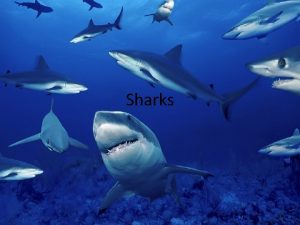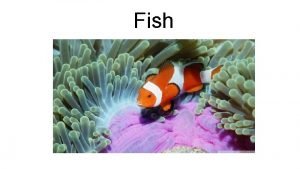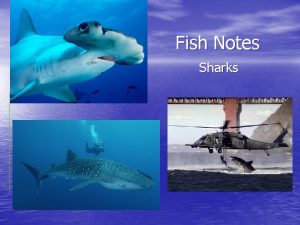12 46 Class Chondrichthyes The sharks skeleton is











- Slides: 11

12: 46 Class: Chondrichthyes The shark’s skeleton is entirely composed of cartilage. The skin is covered with tiny scales called denticles. Feels like sandpaper. They are similar in structure to teeth and cause the skin to be very abrasive if rubbed in the wrong direction. (Native peoples have used it as a natural sandpaper for centuries!) Most have gray, brown, white or black coloring; are not camouflaged but may be counter-shaded. 1

Predation: Efficient, top carnivore of the sick, weak, old and injured. Sharks will not eat a fish called Moses Sole. Researchers think this information may lead to a better shark repellant. Jaw is lined with rows of teeth like a conveyor belt. Teeth can be replaced every 24 hours and are used to identify species. Jaw can be extended out of the mouth for extra reach. 2

Their large liver may help detoxify their diet. It is unusual that they are somewhat resistant to tumors and cancer. However, shark cartilage does not prevent cancer in humans, and sharks with tumors have been observed. Mote Marine Laboratory in Sarasota, FL is a leading research center in shark immunology. 3

Circulation: 2 chambered heart; cold-blooded Respiration: Gills are located in muscular slits behind the mouth. They exchange oxygen from the water into the blood. Sharks lack swim bladders and must constantly swim upwards to balance their weight. They do sleep. 4

Senses: Vision is good in clear water. Eyelids close from the bottom upwards to prevent injury during an attack. Their ability to smell is excellent. Olfactory lobes compose 2/3 of the brain. Sharks can detect a drop of blood 1/4 mile away in the water and can determine the direction of the source. Hearing is also excellent. Sound vibrations can be detected by the lateral line from 3, 000 feet away. The electrical impulses of breathing from a prey can be picked up through pores in the face. 5

Reproduction: sexual, internal fertilization. Most sharks have live births. Dogfish have 4 -10 pups, while tiger sharks may have 80 -100 at one time. A few species of sharks and skates lay eggs. Shark Egg 6

Shark attacks on humans are rare, but with more people in the water the odds are increased. Sharks may be looking for new food sources due to over fishing. Most attacks occur in less than 6 feet of water, at dawn or dusk, during summer months. Risks are also increased for surfers and swimmers in water with reduced visibility. A surfer in black wet-suit, paddling out on a board, may look enough like a seal to interest a shark. 7

Most attacks occur in Florida, California, Australia, and Africa. Florida has 4 times the number reported in California. Most attacks are not fatal. Sharks only kill about 10 people worldwide per year. Bees kill hundreds of people and crocodile/alligator - related deaths number nearly 1000. People have done far greater damage to the shark population, especially the illegal practice of cutting the fins off live sharks to sell for making soup. 8

The whale shark is over 50 feet long. It is a filterfeeder with baleen instead of teeth. Largest shark Most dangerous Great White sharks are found in the temperate and tropical oceans worldwide. 9

Skates and rays are related elasmobranchs and cartilaginous fish. Some are bottom dwellers that eat small invertebrates and some small fish. Others are nekton, like the Manta Ray, and eat plankton. Rays have live births (viviparous) while skates are egg laying (oviparous). Several species of rays have a poisonous spine – skates do not. 10

Largest ray Manta Rays may have a 25 foot wide wing span. Most dangerous Sting Rays have a venomous stinger in their tail. Shuffle your feet when wading to avoid stepping on it. 11
 Great hammerhead vs great white
Great hammerhead vs great white Axial skeleton vs appendicular
Axial skeleton vs appendicular Axial vs appendicular
Axial vs appendicular Axial skeleton vs appendicular skeleton
Axial skeleton vs appendicular skeleton Exocoetus classification
Exocoetus classification What phylum is a shark in
What phylum is a shark in Klasifikasi chondrichthyes
Klasifikasi chondrichthyes Pterion
Pterion Lemon sharks facts
Lemon sharks facts Facts about stingrays
Facts about stingrays Remora and sharks symbiotic relationship
Remora and sharks symbiotic relationship Which sharks lay eggs
Which sharks lay eggs




















